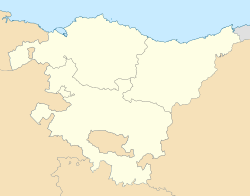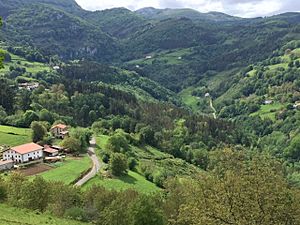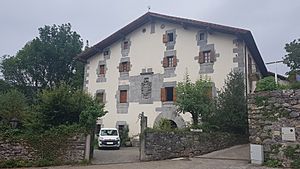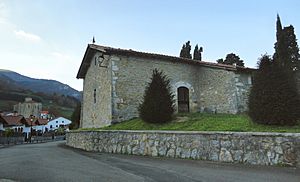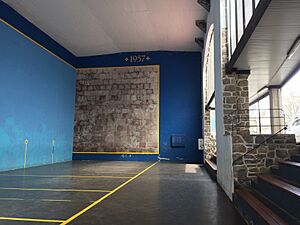Alkiza facts for kids
Quick facts for kids
Alkiza
|
||
|---|---|---|
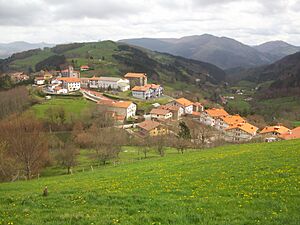
Alkiza in 2010
|
||
|
||
| Country | ||
| Autonomous community | ||
| Province | Gipuzkoa | |
| Comarca | Tolosaldea | |
| Area | ||
| • Total | 11.87 km2 (4.58 sq mi) | |
| Population
(2018)
|
||
| • Total | 374 | |
| • Density | 31.51/km2 (81.61/sq mi) | |
| Time zone | UTC+1 (CET) | |
| • Summer (DST) | UTC+2 (CEST) | |
| Postal code |
20494
|
|
| Website | www.alkiza.eus | |
Alkiza is a small town in the middle of Gipuzkoa, a region in the Basque Country. It is about 27 kilometers south of San Sebastian. In 2019, around 373 people lived there. Most of them (about 88%) spoke Basque. Alkiza became its own town in 1731. Before that, it was part of bigger towns like Tolosa and San Sebastian.
Alkiza is connected to nearby towns like Anoeta and Asteasu by a road called GI-3630. This road made travel much easier. Before the roads were built in the 1950s, people used farm paths to get around.
The main part of the town is 340 meters above sea level. Here you can find the school, the town hall, a pelota court, and the church. Many houses and farms are spread out across the area. The people of Alkiza are sometimes called oiloak (chickens) in Basque. The town's main celebration is on September 8th.
Contents
Exploring Alkiza's Geography
Alkiza is located in the eastern part of the Hernio-Gazume mountains. Most of the area is hilly, with flatter parts found in the Arana neighborhood. The weather here is usually oceanic, meaning it's mild and rainy.
Since Hernio is made of limestone, Alkiza has many cool karst features. These include caves, deep holes, and sinkholes. The Leize Haundia 2 / Sabe-saia cave system is the biggest one in Alkiza. It's 340 meters deep and has 2 kilometers of tunnels with a stream flowing inside!
The highest points in Alkiza are Herniozabal (1,010 m), Herniotxiki (820 m), Enaizpuru (731 m), Alluts (687 m), and Beleburu (619 m) to the west. Mendiola (431 m) is to the east. A large part of the Hernio-Gazume Special Conservation Zone, which is a Nature 2000 protected area, is located in Alkiza.
Waterways and Streams
Because Alkiza is a karst area, much of the rain and melting snow goes underground. This means some streams only have water when it rains a lot. Others only have water in certain parts of their flow.
Alkiza has two main streams:
- The Mandabe stream flows through the Arana neighborhood. It empties into the Oria River in Anoeta. This stream starts at a spring called Bidania erreka. The water from the Leize Haundia 2 / Sabe-saia cave system comes out here. People in Alkiza used to think this water came from the other side of Hernio, from the village of Bidania, which is how it got its name.
- The Aranguren stream starts near the farmhouse of the same name. It flows through the Aldapa neighborhood and joins the Asteasu stream, which is also a tributary of the Oria River.
Neighboring Towns
Alkiza shares its borders with several other towns:
- To the north: Larraul and Asteasu
- To the south: Hernialde, Tolosa, Albiztur, and Bidania-Goiatz
- To the east: Anoeta
- To the west: Errezil
Alkiza Through History
The first signs of people living in Alkiza go back to the Bronze Age. Pottery pieces found in the Olatzazpi cave and a burial mound in Itzuregi show this.
The first written records of Alkiza are from 1348. At that time, Alkiza was linked to Tolosa for administrative reasons. In 1396, Tolosa allowed Alkiza to choose its own judges. Alkiza and other villages had arguments with Tolosa about taxes starting in 1435. Because of this, Alkiza decided to join San Sebastian in 1450, which became official in 1479.
From the 15th to the 18th centuries, Alkiza governed itself. They had open meetings and also appointed judges for daily decisions.
Becoming an Independent Town
The most important moment for Alkiza was when it became its own municipality. On January 21, 1731, King Philip V declared Alkiza a separate town, no longer part of San Sebastian. Being far from San Sebastian was a big reason for this change. Miguel de Irazusta became the first mayor. That same year, the borders of Alkiza with nearby villages were officially marked. There were 54 houses in the new town.
As an independent town, Alkiza could send representatives to the General Assembly of Gipuzkoa. This cost money, so Alkiza suggested that Anoeta join them to share the costs. In 1742, the two towns formed the Ainssu union. In 1815, Hernialde joined, and the group was renamed Ainssuberreluz.
Changes in Land Ownership
In the early 1800s, much of the public land in Alkiza became private. This happened partly because of debts from a war. The town council sold many plots of land. By the end of the 18th century, half of the town's land was public. But between 1799 and 1845, the council sold off most of it. This meant the town council lost a lot of money it used to make from selling wood and charcoal. Because of this, the town lost its resident notaries and forest guards.
Modern Connections
The two Carlist wars in the 19th century did not affect Alkiza much. However, in 1873, there was a small fight in Alkiza during the Third Carlist War. Police and soldiers were looking for a Carlist leader. They were shot at when they entered the village, but they pushed the Carlists out.
Mail service started in 1873 with two postmen. In 1885, the town decided to bring telegraph and telephone services to the village, located in the municipal tavern. Telephones were not in every home until the early 1980s.
In 1911, local business owners built a hydroelectric power station on the Mandabe stream. This brought electricity to Alkiza homes. This plant was a pioneer for the current Elektralkiza power station. Alkiza used this local electricity until 1971, when a larger company installed new power centers. The first car arrived in Alkiza on November 2, 1930.
How Alkiza is Organized
In 1775, the town council divided Alkiza into four neighborhoods: Azaldegi, Aldapa, Arana Behea, and Arana Goikoa. This was to organize collecting things like fern and leaves for animal bedding from public land.
Later, in 1847, when they set up payments for the local doctor, the town was divided into Azaldegi, Aldapa, Arana, and Herriburua. In 1884, Aldapa was split into Aldapa and Hernio. Sakamidra neighborhood was created in 1940.
Today, besides the main town center (called Plaza), Alkiza has five official neighborhoods:
- Aldapa (next to Larraul)
- Arana (a flat area on the road to Anoeta)
- Azaldegi (on both sides of the road to Asteasu)
- Hernio (at the foot of the Hernio mountain)
- Sakamidra (next to Anoeta's Goi-bailara neighborhood)
Population Changes in Alkiza
When Alkiza was first mentioned in writing in the 14th century, it probably had about 60 people. By the early 1600s, there were around 230, and when it became its own town, about 270. In the early 19th century, more than 350 people lived there. The first exact population numbers are from the mid-1800s.
<graph>{ "version": 2, "width": 733, "height": 331.7, "data": [ { "name": "table", "values": [ { "x": 1851, "y": 648 }, { "x": 1860, "y": 611 }, { "x": 1900, "y": 522 }, { "x": 1920, "y": 476 }, { "x": 1940, "y": 494 }, { "x": 1960, "y": 401 }, { "x": 1970, "y": 341 }, { "x": 1981, "y": 272 }, { "x": 1991, "y": 264 }, { "x": 2000, "y": 254 }, { "x": 2011, "y": 365 }, { "x": 2020, "y": 373 } ] } ], "scales": [ { "name": "x", "type": "ordinal", "range": "width", "zero": false, "domain": { "data": "table", "field": "x" } }, { "name": "y", "type": "linear", "range": "height", "nice": true, "domain": { "data": "table", "field": "y" } } ], "axes": [ { "type": "x", "scale": "x" }, { "type": "y", "scale": "y" } ], "marks": [ { "type": "rect", "from": { "data": "table" }, "properties": { "enter": { "x": { "scale": "x", "field": "x" }, "y": { "scale": "y", "field": "y" }, "y2": { "scale": "y", "value": 0 }, "fill": { "value": "steelblue" }, "width": { "scale": "x", "band": "true", "offset": -1 } } } } ] }</graph> Since the early 1900s, Alkiza's population slowly decreased. This drop became faster from the 1960s until the end of the century. The number of people living there was lowest in 2000, with only 254 residents.
In the early 21st century, Alkiza's population is similar to what it was when it became a town. This is because, from the mid-20th century, farming was no longer the main way to make a living. People from Alkiza started working in factories and services in nearby towns. Also, families became smaller, from six or seven children to just two or three.
Alkiza's Economy and Work
Until the mid-20th century, agriculture and related jobs like blacksmithing or working in watermills were the main ways people made money in Alkiza.
Farming was centered around the farm, and most families grew enough food to live on. Unlike other parts of Gipuzkoa, shepherding (raising sheep) was not a big part of Alkiza's economy.
Alkiza historically had three mills: Igaran, on the Mandabe stream, and Olaa and Goiko Errota on the Aranguren stream. The last two mills were used until 1953. They ground corn and wheat. In the 16th century, the Egurrola forge was very active, but it was destroyed by a big flood.
Making Charcoal was an important way for farmers in Alkiza to earn extra money. They sold it to industries and homes in nearby towns like Tolosa. Wood from the Hernio forests was perfect for making charcoal. This activity shaped Alkiza's forests, leading to many beech trees being cut in a special way to grow more wood. This continued until the early 1960s.
Between 1945 and 1950, some local business owners built a system of cables and pulleys to bring beech wood down from the Hernio forests. This wood was sold to bakeries to bake bread.
In the late 20th century, Alkiza had a small industrial area, but it's not active anymore. Baldosas Jarri was the main company there.
Today, Alkiza has very few local businesses. Most people work outside the town, mainly in factories and services in the region. Many university professors also live in Alkiza. In 2020, Alkiza's businesses included two farms, a rural hotel (Lete), the Inazio Urruzola Txakoli winery, the town restaurant, the Elektralkiza mini hydroelectric plant, and a sharpening company.
Learning in Alkiza
Soon after becoming a town, Alkiza's council decided to focus on educating its people. In 1749, the first notary (a legal official) in town also had to teach reading and writing.
This continued until 1797, when the town council hired the first teacher who was not a notary. His job was to teach children Christian lessons, reading, writing, and counting. Families paid the teacher in wheat, and he also received a salary from the town. The school was in the council building. The teacher also had to take care of the church clock.
In 1816, the school moved to the Migelena house, which was rebuilt by two brothers. The priest, Juan Bautista Legarra, taught there from 1822 to 1843. A mistress was also hired to teach the girls. The first one was Juana María Aranburu. Juan Bautista Legarra later gave the school building, known as Donjuanena, to the town to be used as a school.
The school stayed at Donjuanena until 1930, when a new one was built. In March 2020, a brand new school building opened. It replaced the old one, which had become too small and old-fashioned. Alkiza's school offers preschool and primary education. Students older than 12 usually go to Villabona or Tolosa for secondary education.
The Basque Language in Alkiza
In 2016, about 88.8% of people in Alkiza could speak Basque. The language is used a lot in daily life (83.6% in 2017). At the school, Basque is the main language used for teaching.
Since December 2019, Alkiza has been a member of the Commonwealth of Basque-speaking Municipalities (UEMA). This group helps support the use of Basque.
People in Alkiza speak the Tolosaldea version of the Gipuzkoan dialect of Basque. However, because Standard Basque is used in schools and media, and people interact more with speakers of other dialects, younger generations often speak a mix of different Basque styles.
The Ahotsak website has recordings of 8 older people from Alkiza. These recordings show how the traditional Basque dialect was spoken there.
Culture and Creativity in Alkiza
Alkiza is a town with lots of cultural activities. Throughout the year, there are many events like talks, music shows, art exhibitions, and theater performances. Two special cultural weeks are also organized, one in May and another in November.
Between 2008 and 2010, residents worked on a cultural project called Itxurain. Its goal was to collect the town's history, traditions, and culture. They wanted to use this heritage to help shape the community's identity in the future. Many residents and the school took part in four different projects.
Since 2018, the Sormenaren Kabia (Nest for Creativity) program has been running. Each year, it gives two artists a grant, a place to create art, and advice from local sculptor Koldobika Jauregi during their time in Alkiza.
The Ur Mara open-air museum is located by the road to Asteasu. It is run by sculptor Koldobika Jauregi and his wife, jewelry designer Elena Cajarabille. The museum shows their work and art from other artists. It also hosts concerts, exhibitions, and workshops every year.
The painter Juan Luis Goenaga has his art studio in the Aritzategibarrena farmhouse in the Hernio neighborhood.
Important Buildings and Landmarks
Lete Manor
Lete, also known as Alkizalete, is a manor house with medieval roots. It was home to the Alkizalete family, one of the wealthiest families in Alkiza until the 19th century. The house has a rounded arch and Gothic-style panels on the ground floor. It also has wooden pillars and beams from the 16th century. The year 1212 is carved on the coat of arms on the front of the building. The current house is a baroque building from the 18th century.
San Martin de Tours Church
The parish church of San Martin de Tours is built in the Gothic style. It got its current look in the second half of the 16th century. The original church did not have a tower, which was added in the 17th century.
The church's original altarpiece (a decorated screen behind the altar) was thought to be by the famous sculptor Joanes Antxeta. However, new information shows that the sculptor Joanes de Arbeiza made it. Antxeta was called to Alkiza to advise on the altarpiece.
The tabernacle (a small cabinet for sacred items) in the church is from the same time. It was made by local sculptor Ambrosio Bengoetxea. It is now kept in the Diocesan Museum of San Sebastian, where it was taken for restoration in the early 1980s.
The church's tower and sacristy (a room where clergy prepare) were built between 1688 and 1700.
The current altarpiece was made by Miguel de Irazusta, a local architect living in Madrid. He started working on it in 1724 and finished when he became the town's first mayor. Between 1755 and 1772, during the time of parish priest Juan de Irazusta (Miguel's cousin), the church was improved. The choir arch, new church floor, and portico were built, and a clock was put in the tower. This clock was fixed in 1841 and 1932.
The church organ was installed in 1928. Between 1998 and 2000, the church of San Martín was greatly restored. The European Union helped pay for some of this work.
Santiago and Holy Cross Chapels
We don't know when the Santiago chapel (hermitage) was built. Today, it is part of a complex with the cemetery, next to the local car park. Old papers also called it a hospital. The first time it was mentioned in writing was in 1528. Because it was also called a hospital, some people thought that a path of the Camino de Santiago (Way of St. James) might have passed through Alkiza.
People in Alkiza often left gifts to the chapel in their wills. In 1762, the San Martín church asked architect Martín Carrera to build a path with crosses (a calvary) from the church to the chapel. We don't know when it was built, but about half a dozen crosses are still standing.
A few years later, on June 22, 1771, the bishopric of Pamplona stopped masses from being held in the chapel because it was in bad condition. This ban lasted until 1832. That same year, the bishopric allowed the chapel to be restored. This was because they had decided to tear down the other chapel in the village, the Holy Cross chapel.
Masses were held in the Santiago chapel until 1977. The Good Friday procession from the church to the chapel continued until 1979. Today, the chapel is no longer used for religious services.
The Holy Cross chapel was about half an hour away from the town center and 520 meters above sea level. The old path from Alkiza to Hernio passes by its ruins. It was first mentioned in 1528. In 1832, the bishopric of Pamplona allowed it to be torn down. They said it was too far from the town and its walls were falling down.
Cemetery
Until the early 18th century, people were buried inside San Martín's church. The cemetery itself was built in 1708 next to the Santiago chapel. For more than a hundred years, people were buried in either the church or the cemetery. From 1828, only the cemetery has been used for burials.
The church managed the cemetery until 1885, when the town council spent money to make it bigger. Since then, the town council has managed it. In 1945, the cemetery was expanded again and got its current shape. In February 1926, the bones of those buried in San Martin's church were moved to the cemetery.
Pelota Court or Fronton
The pelota game has been played in Alkiza for a very long time. This is shown by old place names like Pelotaleku (place where pelota is played). The first written mention is in the town rules from 1735. These rules said that playing pelota was not allowed in the church's entrance during worship times.
However, the first pelota court with a left wall was not built until 1922. It was paid for by a paper mill from Irura. This was part of the project to build the Elektralkiza hydroelectric power station. The left wall was built against the San Martín church. This was an important project because no other nearby villages had a fronton with a left wall. Telesforo Arregi, a local professional pelota player, said in 2003: "In the surrounding villages there were no fronton with a left wall and the one that had a liking ... all to Alkiza. From Hernialde, from Asteasu ,. In Asteasu there was only a small portico ..."
The current covered fronton was opened on December 15, 1957. It was built by the Gipuzkoa Provincial Council. In the opening match, Atano X and Atano IX beat Atano III and Atano IV, 20–17.
Since it was one of the few covered frontons in Gipuzkoa, many people from other towns came to play. This continued until the 1980s, when covered frontons started to be built in all towns in the province.
Other Interesting Places
- Some parts of Alkiza's heritage include the Intxarraundiaga's limekiln, the Altzorbe's and Etxabeguren Berri's fountain-sink, the water channels of Goiko Errota mill, the paved roads of Ilumbe, Askantxo and Lakapide, the Elektralkiza’s dam, and the wall of the Mariategi farmhouse garden.
- Fagus-Alkiza Interpretation Centre: This center is the gateway to the Hernio-Gazume Special Conservation Area, which is part of the Natura 2000 network.
Famous People from Alkiza
- Martin Díez Liatzasolokoa (1500–1583), a sculptor.
- Anbrosio Bengoetxea (1551–1625), a sculptor.
- Miguel de Irazusta (1665–1743), an architect.
- Joan Bautista Intxaurrandiaga (1680?–1747), a mason.
- Juan Irazusta (1688–1772), a writer.
- Joan Elias Intxaurrandiaga (1735–1800?), a sculptor.
- Antonio Sorrarrain (1928–2011), a writer.
- Pello Joxe Aranburu Ugartemendia (1936-), a teacher and writer.
- Luis Mari Arantzabe (1949-), a pelota player.
- Juan Luis Goenaga (1950-), a painter.
- Arantza Diaz de Illarraza, a University professor and member of Ixa Research group.
- Xabier Artola (1957-), a University professor and member of Ixa Research group.
- Inaki Irazabalbeitia (1957-), a writer, MEP (Member of European Parliament), and member of the Academy of the Basque Language.
- Koldobika Jauregi (1959-), a sculptor.
- Barbara Goenaga (1983-), an actress.
See also
 In Spanish: Alquiza para niños
In Spanish: Alquiza para niños



